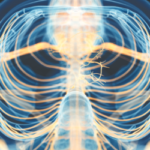Numerous studies expanded this work, including an experiment which established that electrical stimulation of the vagus nerve also significantly attenuated TNF synthesis and shock during reperfusion injury in rats.2 Another team member compared response to vagus nerve stimulation in wild type and alpha 7 knockout mice, and confirmed that the nicotinic acetylcholine receptor subunit alpha 7 is an essential regulator of inflammation.3
Another Thread
Another line of exploration was simultaneously being followed at the University of California, San Diego (UCSD). In his talk, Gary S. Firestein, MD, professor of medicine; chief of rheumatology, allergy, and immunology; and dean of translational medicine at UCSD, described the path that led him and his colleagues to related conclusions about CNS–immune system “cross-talk.” In early 2000–2003, they had begun to investigate the role of spinal adenosine in regulating peripheral inflammation. Delivering tiny amounts of adenosine receptor agonists via intrathecal catheters implanted in rats, the team was able to block skin inflammation induced by intradermal carrageenan.4 In a rat model of rheumatoid arthritis they established that peripheral inflammation is sensed by the central nervous system, which subsequently activates stress-induced kinases in the spinal cord via a TNF alpha–dependent mechanism.5 Intracellular p38 MAP kinase signaling processes this information and modulates the body’s inflammatory responses.
When Dr. Firestein and his team became aware of Dr. Tracey’s work, they traveled to his laboratory to try to connect these two narratives of CNS–immune system communication. Initial collaborative experiments focused on measuring whether administration of galanthamine, an acetylcholine esterase inhibitor, would alter vagal outflow—and when it did increase outflow, then applying this to their adjuvant arthritis model. Animals treated with saline after paw carrageenan injection showed swelling, whereas animals treated with galanthamine had little swelling. They showed similar antiinflammatory results when they blocked p38 intrathecally. The UCSD group was also interested in focusing on acetylcholine receptors in synoviocytes. “We, being no fools,” quipped Dr. Firestein, “decided to leverage our collaborators’ experience and focused on the alpha 7 receptor.” And, indeed, the team found that alpha 7 is constituitively expressed in both RA and OA synoviocytes.
Dr. Firestein concluded, “We started out looking at how spinal p38 regulates arthritis, and then found subsequently that it also regulates vagal outflow. There is a very dynamic interaction between the periphery sensing damage, relaying that information to the spinal cord, which subsequently provides information further north in the neural axis, and then provides a feedback loop back out to the periphery.”
Implications for RA Therapies
Understanding the pathways and mediators by which CNS–immune system “cross-talk” occurs can open possibilities for novel therapeutics, noted Paul-Peter Tak, MD, PhD, of the Academic Medical Center a the University of Amsterdam, The Netherlands, in his talk. He and his colleagues have augmented the work done by the Tracey and Firestein teams. For example, they cultured fibroblast-like synoviocytes from the joints of patients with active RA, stimulated the cells with TNF-α, and added nicotine, which stimulates the alpha 7 receptor, thus confirming that the alpha 7 receptor is expressed in the synovium.6 They also showed, in a collagen-induced rat model, that the cholinergic antiinflammatory pathway is involved in synovial inflammation in vivo.7 It is clear that the cholinergic antiinflammatory pathway allows the nervous system to communicate with the immune system. We now have converging scientific evidence that the autonomic nervous system plays a key role in regulating the magnitude of immune responses to inflammatory stimuli—in real time.


